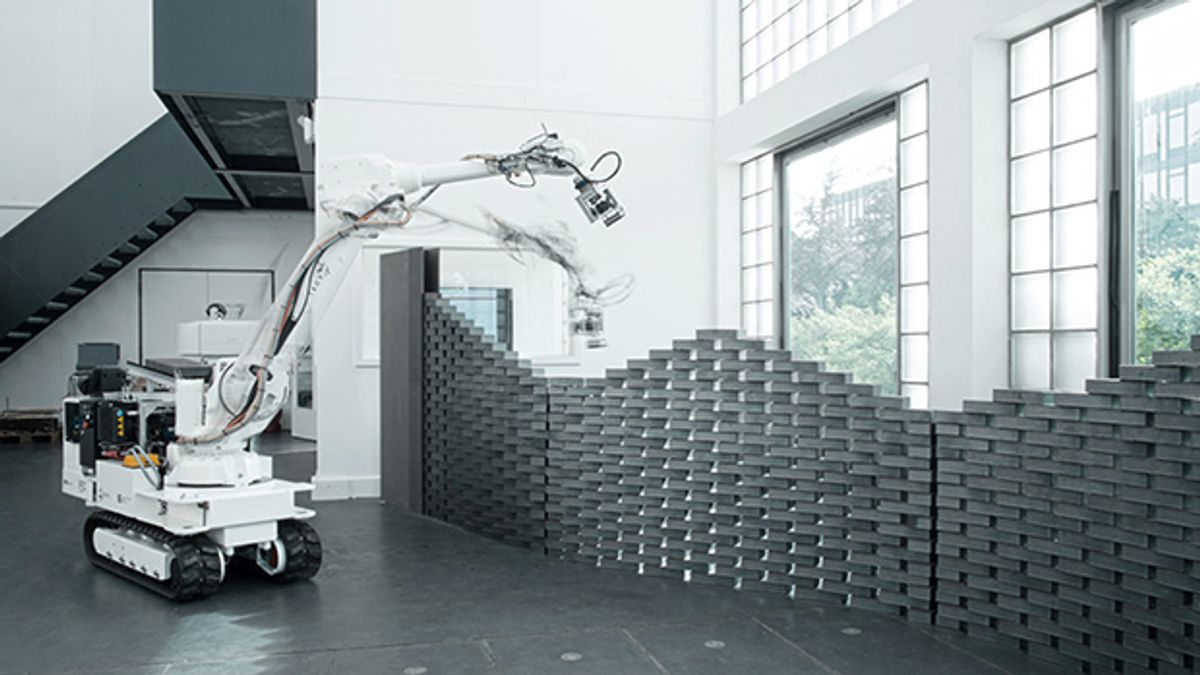Last week, we wrote about some robots that are making construction more efficient by automating work with bricks and concrete. At ETH Zurich, the Swiss National Science Foundation (through the National Centres of Competence in Research) has just opened a Digital Fabrication lab that’s exploring what else is possible with construction autonomy, and they’ve come up with some very cool ideas.
The flagship project (for the moment, in that it looks to be the most complete) is the In-situ Fabricator, an autonomous construction robot. It’s an industrial arm on a mobile base that can lay bricks, but the difference between this system and the one from last week is that the In-situ Fabricator is designed to be completely self-contained, without requiring any external localization systems. The robot has a 2D laser rangefinder on it, and once it gets to the construction site, it can build up a 3D map that gets registered to existing localized structural plans. That way, the robot always knows where it is, and can move around a construction site without any additional infrastructure, even autonomously adapting to minor design variations when necessary.
Even though the In-situ Fabricator is, arguably, much more intelligent than last week’s bricklaying robot, it’s also much farther from commercialization, requiring humans to feed it bricks. It also places bricks without mortar, which is something to keep in mind if you were expecting the walls that it puts up to stay up for any appreciable length of time. It’s not necessarily the focus of this project to make a completely commercially viable robot, and these issues are solvable, but we’re certainly looking at a construction robot here that’s most comfortable in a lab environment, for the moment.
Another project from the NCCR Digital Fabrication program is “robotic aggregations of materials with unpredictable geometry,” which is developing a system that can build things out of rubble, basically:
The use of building materials with unpredictable geometries, such as raw quarry stones or recycled concrete rubble, is a challenge for the traditions of digital fabrication. This research work focuses on developing advanced three-dimensional scanning of materials, real-time analysis, and digital robotic fabrication that is able to respond to such irregular materials. The goal for this research is therefore to define an innovative and environmentally sound building system that foregoes traditional binding materials, reinforcement systems and formwork.
This last one is called Mesh Mould:
This project explores the folding of two separate yet essential concrete construction components – reinforcement and formwork – into a unified robotic fabrication process. The idea is a digitally-controlled extrusion process of bespoke “leaking formwork” elements for non-standard concrete structures that are environmentally sound and structurally lean, and that can be efficiently fabricated directly on the construction site.
If buildings could take advantage of these customized concrete forms (which are tedious for humans to construct), it would make interesting architecture much more affordable, and by optimizing form for function, you could potentially save a lot of time, money, and material by not having to over-engineer structures.
There are a huge number of other projects on the NCCR Digital Fabrication initiative that are worth checking out; we’ve only featured a couple of them here, so click the link below to see everything that they’re working on.
[ dfab ]
Thanks Jonas!
Evan Ackerman is a senior editor at IEEE Spectrum. Since 2007, he has written over 6,000 articles on robotics and technology. He has a degree in Martian geology and is excellent at playing bagpipes.





